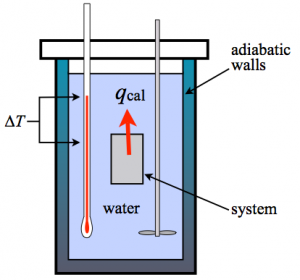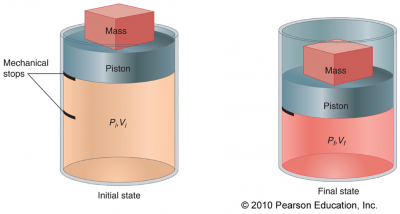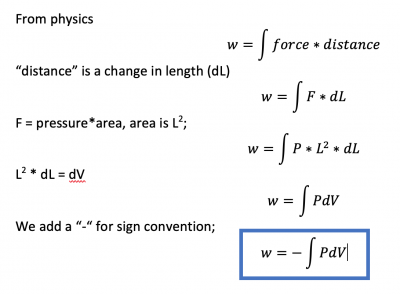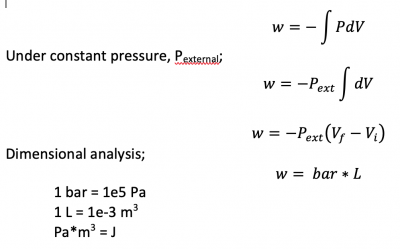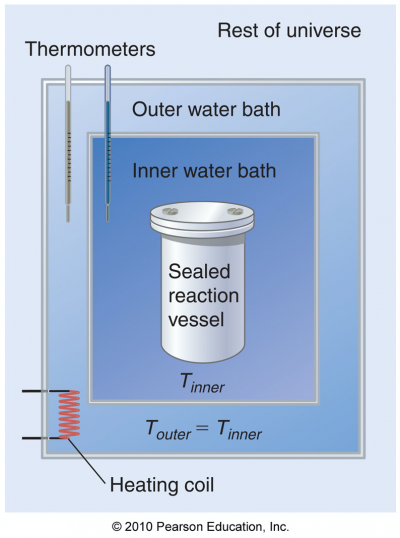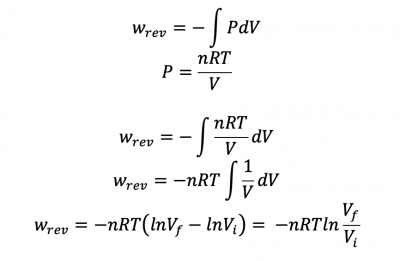Difference between revisions of "PChem312 f20 w3"
| (2 intermediate revisions by the same user not shown) | |||
| Line 105: | Line 105: | ||
====Sec 2.4: Equilibrium, Change, and Reversibility==== | ====Sec 2.4: Equilibrium, Change, and Reversibility==== | ||
:READ | :READ | ||
| − | ====Sec 2.5: Reversible Work | + | ====Sec 2.5: Reversible Work==== |
| − | : | + | [[File:Screen Shot 2020-09-07 at 8.28.46 AM.png|400px]] |
====Sec 2.6: Irreversible Work==== | ====Sec 2.6: Irreversible Work==== | ||
| − | : | + | [[File:Screen Shot 2020-09-07 at 8.27.24 AM.png|400px]] |
| − | |||
| − | |||
| − | |||
Latest revision as of 13:29, 7 September 2020
Monday, Aug 31, 2020
Continue reading chapter 2
Sec 2.1: Internal Energy and !st Law of Thermodynamics (review)
U <-- internal energy (1st thermodynamic state function)
- Uf - Ui = ΔU, the change in the internal energy
- we cannot measure Uf or Ui, only ΔU.
First Law of Thermodynamics: the change in the system's internal energy is equal to, but opposite in sign, to the change in the surround's internal energy.
- ΔUsys = - ΔUsurr
How does one measure ΔU?
- - changes in the system variables (ΔP, ΔV, ΔT, Δn) are an indication of ΔU; changes in system variables result in either heat (q) transfer or work (w) being done on or by the system; calculation of q or w leads directly to ΔU.
- ΔP, ΔV, ΔT, Δn --> q (heat), w (work) --> ΔU
- Heat and work are both defined as a transfer of energy between the system and surroundings.
The first Law of thermodynamics can also be stated as:
- ΔU = q + w
Sec 2.2: Heat (q)
- Heat is transitory; heat is not a thing. We DO NOT use the term Δq (for change in heat), we instead say that heat flows from one place to another.
- Heat naturally flows from hotter/higher temperature to cooler/lower temperature objects (Zeroth Law of Thermodynamics).
- Heat sign convention
- - we speak of heat from the perspective of the system (unless otherwise stated).
- - when the system loses heat, we identify this quantity of heat as negative (or lost), -q; loss of heat is generally associated with a decrease in temperature, ↓T.
- - when the system gains heat, we identify this quantity of heat as positive, +q or q (or gained); ; gain of heat is generally associated with a increase in temperature, ↑T.
- Example
heat (or caloric <-- historical) is measured by using a heat-meter or a calorie-meter, or calorimeter; hence calorimetry.
- measure ΔT --> ΔT ∝ q,
- q = mass of H2O * specific heat/heat capacity * ΔT
- Note: heat capacity is not really a constant...
Wednesday, Sept 2, 2020
Sec 2.2: Work (w)
- Work is transitory, only energy, not work is associated with the initial or final states. We DO NOT use the term Δw (for change in work), we instead say that work was done on or by the system.
- Work occurs when a force is applied by the system or on the surroundings.
- Work sign convention
- - we speak of work from the perspective of the system (unless otherwise stated).
- - when the system does work on the surroundings, we identify this quantity of work as negative (or lost), -w.
- - when the system has work done on it by the surroundings, we identify this quantity of work as positive (or gain), +w or w.
Details
Example Work (expansion) Calculation
Calculate the work involved when 20.0 L of an ideal gas expands to a volume of 85.0 L against a constant pressure of 0.980 bar.
Types of Work (Table 2.1)
- - Expansion work --> ΔP, ΔV, units Pa*m3 = J
- - Electrical work --> Potential (V <-- sorry not volume), current (I in amps), units Volts*charge = J
- - others...spring stretching/contracting, surface tension, etc. (not discussed here).
Heat/Work (Electrical) Example
Adiabatic Calorimeter
Consider an adiabatic calorimeter where the inner bath (400 g H2O) temperature increases by 12.2 deg C; how long would the heater (120 V, @4.17 amps) run in order to insure that the outer bath (400 g H2O) would be at the same temperature?
- (P = I * V; w = V * I * sec; J = P * sec)
- answer: 41 sec
Thursday, Sept 3, 2020
Meet in CSB 378
Activities
- - PChem Toolbox check
- identify tools --> list of toolshere
- does circuit tester work...plug it in...
- Demo of Kill-A-Watt (1500 W heating element, stirring hot plate)
- - Thermometer calculation/Excel
- Equation here
- Set up spreadsheet (calculate change in height of liquid given other variables)
- Measure glass tubing dimensions (use calipers from toolbox)
- Use Excel to determine thermometer dimensions
- - Make thermometer
- Cut tubing
- Glass blow thermometer bulb
- Fill
- Calibrate
- - Worksheets
- Internal Combustion Engine
- Heating/Cooling worksheet
- Constant pressure work
- Electrical work
- Adiabatic Calorimeter
- non-constant pressure work (small lecture)
Friday, Sept 4, 2020
Announcements
- - you should have a thermometer ready to be filled and calibrated by next lab period. Glass blowing area is open for use (work in pairs, pls)...just let me know.
Sec 2.4: Equilibrium, Change, and Reversibility
- READ
